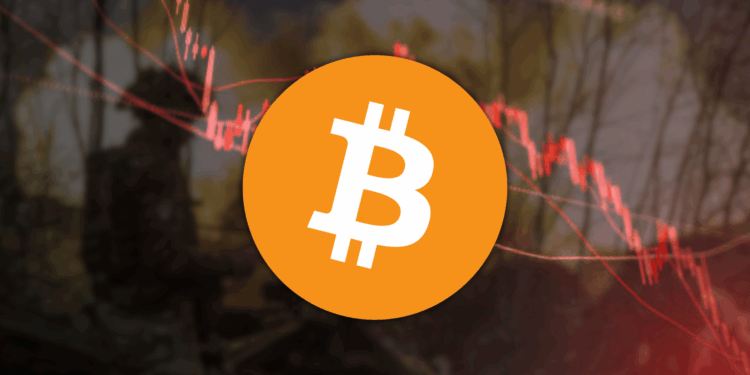- War fears are rattling the crypto market, triggering panic selling and a flight to safety—but the actual risk of a global conflict like WW3 remains low, though regional tension is likely to keep volatility high.
- While crypto would probably drop hard in the short term if a major war broke out, long-term effects could actually favor decentralized systems as trust in traditional institutions erodes.
- Staying calm, sticking to a plan, and prepping for sharp market swings—rather than reacting emotionally—is key to surviving and thriving through geopolitical chaos.
Markets are rattling. Headlines are screaming. “World War III” is trending again—and whether it’s media hype or a legitimate threat, investors are reacting. Safe-haven assets are climbing, Bitcoin just took a beating, and fear is spreading fast. But this isn’t the time to panic—it’s the time to plan.
With global tensions on the rise, it’s crucial to understand what’s actually moving the markets, how deep this correction could go, and whether we’re looking at a temporary shakeout… or the start of something far more serious. Either way, those who prepare—not just react—are the ones who come out ahead.
Let’s take a deeper look at what’s going on.
Why Markets Are Reacting So Strongly to War Headlines
Over the past few weeks, financial markets have grown increasingly unstable. It’s not hard to see why—escalating conflicts in the Middle East and Eastern Europe, threats of nuclear engagement, and the ever-present whisper of U.S. intervention have all contributed to a steep decline in risk assets.
Crypto, of course, is feeling it the hardest.
Bitcoin dropped nearly 10% in just two days. Over $1 billion in crypto liquidations hit the market almost overnight. That’s not just volatility—it’s fear manifesting in real time.
Investors are fleeing to safety. Gold, U.S. Treasuries, and even stablecoins are seeing increased activity, while high-risk sectors like altcoins are under pressure. The headlines are fueling it: missile strikes, drone attacks, and serious geopolitical rhetoric are dominating the news cycle. Every time “WW3” trends on social media, the crypto market feels it within hours.
And this is where psychology takes over. When investors feel unsure, they hesitate—or worse, they panic. That hesitation can snowball into cascading sell-offs, breaking support levels and dragging sentiment lower across the board.
Still, it’s important to zoom out. Markets tend to overreact to uncertainty, especially when emotions run hot. Historically, these kinds of fear-driven dips often reverse once the panic cools and no worst-case scenarios play out. The question now is—how likely is actual global war?
Could We Really Be Facing World War III?
It’s the fear behind the fear: are we truly on the edge of a global conflict?
While tensions are undeniably rising, most experts agree that a full-scale global war remains unlikely. Nuclear-armed countries like the U.S., China, and Russia understand the consequences. Nobody wants total destruction. What we’re seeing instead is a mix of posturing, proxy conflicts, and strategic influence plays.
That said, all it takes is one misstep.
False-flag events. Escalations at sea. A misinterpreted missile launch. History has shown us that wars don’t always begin with clear intentions—they can unfold through a series of small, compounding decisions. The Israel-Iran conflict, NATO-Russia standoffs, and economic sanctions all add layers of risk. Even the mention of nuclear escalation—whether bluster or not—spikes market volatility instantly.
And here’s the key: markets don’t wait for war to begin. They react to the possibility of it. Investors don’t trade on what has happened—they trade on what might happen next. That’s what’s fueling this volatility.
While the chances of true World War III remain low, the odds of continued regional conflict, cyberattacks, supply chain disruption, and economic sanctions? Unfortunately, those are far more likely. And for global markets—including crypto—that’s more than enough to create turbulence.
Would World War III Crush the Crypto Market?
If war on a global scale were to break out, yes—crypto would almost certainly drop sharply in the short term.
High-risk assets like Bitcoin, Ethereum, and altcoins are always the first to go when investors enter panic mode. We’ve seen it before. During the early stages of the Russia-Ukraine war, BTC took a quick dive before rebounding weeks later. The initial selloff would be brutal—but history suggests it wouldn’t last forever.
In fact, there’s an argument to be made that long-term, crypto could benefit from geopolitical chaos.
Think about it: if traditional systems begin to crack—if fiat currencies are debased, if international transfers like SWIFT become compromised, if trust in centralized governments weakens—then decentralized networks become a lifeline. Bitcoin was born in the shadow of a financial crisis. A breakdown in global order could push crypto further into the mainstream, not out of it.
But we can’t ignore the flip side. Governments often use crises as justification for increased surveillance and control. In the name of national security, they might target decentralized platforms or introduce restrictive regulations. That could cause temporary disruption—even if it also validates why crypto exists in the first place.
Bottom line: if a conflict escalates, expect volatility. But don’t mistake panic for permanence. Strong conviction, thoughtful positioning, and a long-term view are what separate reaction from resilience.
How to Prepare for the Unknown Without Losing Your Edge
You can’t predict the future—but you can be ready for it.
Start by zooming out from daily price swings. Focus on positioning, not guessing. If you believe in Bitcoin, Ethereum, or key projects with long-term value—continue dollar-cost averaging. Stick to a consistent plan and avoid emotionally chasing or dumping positions based on headlines.
Keep a portion of your portfolio in stablecoins or cash. That dry powder becomes powerful when markets pull back—bear markets are where real wealth is made. Just make sure whatever you hold, you can emotionally tolerate seeing drop 50% or more. That’s the reality of crypto. It moves fast, both directions.
Next: get plugged into strong, informed communities. Whether it’s a private group or a curated feed of analysts and traders, surrounding yourself with clear-headed voices is invaluable when emotions run high. The more informed your inputs, the sharper your decisions.
Lastly, fortify your mindset. Black swan events, fear cycles, and media panic aren’t going away. The investors who thrive are the ones who expect turbulence—and build through it anyway.
Final Thoughts – Fear Is Real, But So Is Opportunity
Yes, the world feels unstable right now. Geopolitical threats. Economic uncertainty. Market shocks.
But this is exactly where sharp investors shine. By staying calm, sticking to a strategy, and thinking longer than the current news cycle, you position yourself ahead of the crowd.
The worst time to build conviction is during euphoria. The best time? When things feel uncertain—like now.
So stay focused. Keep learning. And be ready to act when others hesitate.
The opportunities won’t come with a headline. They show up when you least expect them—hidden inside fear, uncertainty, and doubt. Make sure you’re ready when they do.














